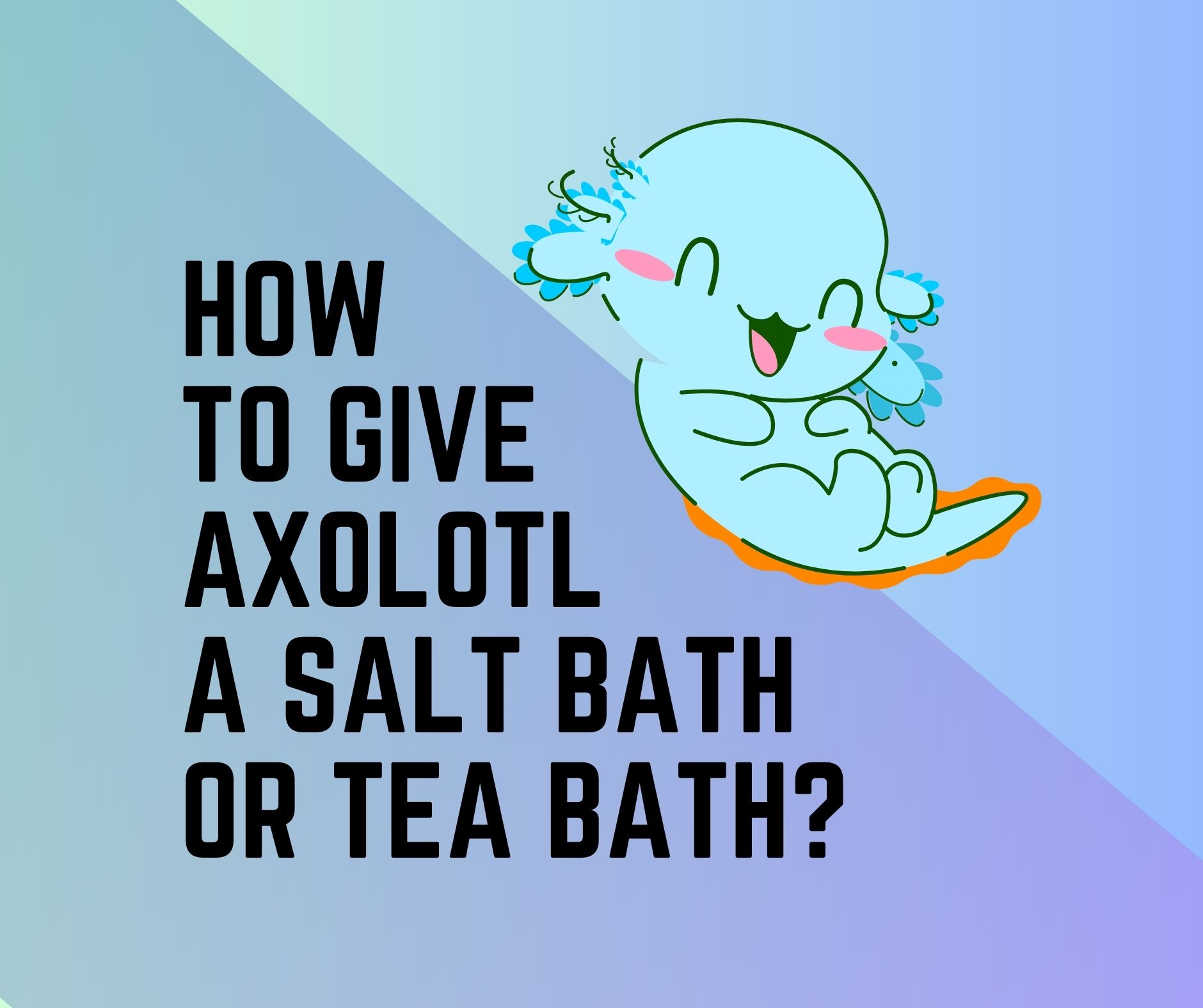
Axolotls are fascinating aquatic creatures and one of the popular pets nowadays. These aquatic beings require specific care and maintenance in order to stay safe and healthy. Though keeping Axolotls is easy and hassle-free, sometime the animal may suffer from some issues.
It isn’t uncommon for Axolotls to suffer from a fungal infection. Has your pet, too, been in one such situation? Well, then, have you ever considered giving him a Salt Bath?
A salt bath is a popular way to keep your Axolotl healthy, preferably free from infection. However, the Salt bath isn’t a prevention practice but a treatment if the Axolotl is suffering from some kind of skin ailment.
Many axolotl owners may be unsure of how to do this correctly. If you, too, are one of them, then join us in this article, and let’s find out the correct way. We will also discuss other details associated with the topic.
Axolotl Salt Bath Process
For an Axolotl keeper, it is important to understand why salt baths are beneficial for these creatures.
Axolotls are inhabitants of freshwater environments. However, they may occasionally develop skin irritations or fungal infections. And a salt bath helps to reduce such irritations and infections while also aiding in the shedding of dead skin cells.
However, it is important to remember that giving your Axolotl a salt bath isn’t as simple as it may sound. It should not be done too frequently since salt baths can cause stress and harm to the Axolotl, especially if not done correctly. That is why, when administering a salt bath, it is crucial to follow the proper procedures.
Are Salt Baths Good For Axolotls?
Yes, salt baths can be beneficial for axolotls as long as you are doing them correctly and only in need. Pet keepers should keep a check on not giving unnecessary salt baths to their Axolotls, or it may have adverse effects.
When performing a salt bath, pet owners should focus on using the correct amount of salt and the right type of salt. Also, the appropriate duration to avoid causing harm or stress to your Axolotl is important.
Too much salt or leaving your Axolotl in the bath for too long can have negative effects. These effects can range from dehydration and burning the gills to skin damage. Also, the wrong type of salt in the salt bath can prove harmful for Axolotls. For instance, Table salt contains high levels of iodine, and it can damage the thyroid gland and cause thyroid disorders in Axolotls.
Besides, some salts contain anti-caking agents and other additives that can cause skin irritation, respiratory problems, and other health issues in Axolotls. Therefore, it is important to use an aquarium or marine salt or one that is specially formulated for the marine environment. In addition, it is also essential to follow the proper procedures when administering a salt bath to your Axolotl.
What’s more important to know is that salt baths should not be used as a preventative measure. Salt baths for Axolotls are advisable for a specific skin issue, and they shouldn’t be used for anything more than that. Also, in some cases, it may be necessary to seek veterinary advice before giving your Axolotl a salt bath.
10 Benefits of Salt and Tea Bath For Axolotls Pointwise
Axolotls are a type of salamander that are commonly kept as pets. They are known for their unique appearance and ability to regenerate their limbs. Bathing axolotls in salt or tea baths can provide several benefits for their health and wellbeing. Here are some of the benefits of salt or tea baths for axolotls:
- Helps prevent bacterial infections: Salt baths can help prevent bacterial infections on the axolotl’s skin and gills. The salt helps to kill any harmful bacteria and can promote healing if the axolotl has any wounds.
- Aids in shedding: Axolotls shed their skin as they grow, and tea baths can help soften the skin and make it easier for the axolotl to shed. This can prevent any skin damage or infections that can occur during shedding.
- Provides a relaxing environment: Bathing axolotls in tea can provide a relaxing environment for them. The tannins in the tea can help reduce stress and promote relaxation.
- Helps with fungal infections: Tea baths can also help with fungal infections on the axolotl’s skin. The tannins in the tea can act as a natural antifungal agent.
- Reduces stress: Salt and tea baths can help reduce stress in axolotls. The change in environment and the presence of the salt or tea can provide a calming effect on the axolotl.
It’s important to note that salt or tea baths should be done in moderation and under proper guidance. Axolotls have delicate skin and can be sensitive to changes in water quality, so it’s important to use the correct amount of salt or tea and to ensure that the water is at the proper temperature and pH level.
How Much Salt Do I Put In My Axolotl Tank?
It’s essential to use the correct amount of salt when performing a salt bath for your Axolotl.
The recommended concentration for a salt bath is 0.1% to 0.2%. Approximately one to two teaspoons of aquarium salt per gallon of water.
CAUTION: Please consult a veterinarian about how much salt you should use. Especially if you’re unsure about the appropriate amount of salt to use, it’s always best to seek advice from a veterinarian or a knowledgeable aquatic specialist. Avoid going by any random information present online. An expert in the field can help you with the appropriate salt concentration for your Axolotl’s specific needs.
Besides that, it is also important to note that the concentration of salt in your axolotl tank should not exceed 0.1%. Remember, higher concentrations can be harmful to your pet. Also, do not use salt as a regular additive to your Axolotl tank water. Axolotls are freshwater creatures, and they cannot tolerate high levels of salt for an extended period.
Are Tea Baths Good For Axolotls?
Axolotls are aquatic salamanders, and they are not adapted to living in tea baths. Some people believe that tea baths can have benefits for axolotls as it helps to prevent bacterial infections or promote healing. However, there is no scientific evidence to support these claims.
In fact, exposing axolotls to tea baths may actually be harmful to them. The tannins in tea can have astringent properties that can irritate Axolotl’s skin and gills. In addition, the caffeine content in tea can also be toxic to Axolotls.
Therefore, it is not recommended to use tea baths for axolotls until a specialized veterinarian has recommended doing so.
10 Things to know before giving Axolotl a Salt or Tea Bath
- Axolotls are native to freshwater, and thus for either process of bathing, they need clean, cool water. The water temperature should not exceed 70 °F.
- Axolotls have very sensitive skin and are susceptible to absorbing chemicals through their skin. It is usually recommended to avoid using any product in their bath water. That is why, before you use salt or tea, please consult a veterinarian.
- Monitor your Axolotl closely during a bath, and if you suspect any kind of stress or discomfort, transfer them to clean water immediately.
- Rinse your Axolotl after the bath to remove any residue or substances from the skin.
- Always use dechlorinated water only.
- Make sure the container size is appropriate. It should be big enough for the Axolotl to move but not immensely large that the poor pet becomes stressed.
- Always keep the bath short, typically no more than 15 minutes.
- Do not use salt baths or tea baths as regular treatment until a veterinarian has recommended the same.
- Always keep the temperature consistent for the Axolotl. If you have removed the pet from the fridge, do not transfer it to the water immediately, or it will give them a temperature shock.
- Use salt or tea that is safe for Axolotl.
Axolotl Tea Bath Vs. Salt Bath- Stepwise Guide
step-by-step guide on Axolotl Tea Bath:
- Take two plastic tubs of 5 to 10 liters and fill them both with dechlorinated water.
- Now in each tub, add 2 to 3 drops of Seachem Prime.
- Next, in Tub 1, prepare a tea bath using either 100% pure black tea, Indian almond leaves, or oak leaves. Use 1 tea bag (or 1 tablespoon of tea) for every 10 liters of water. You can either boil the tea and dissolve it or let it dissolve in cold water, though the latter with take more time.
- NOTE: Water temperatures should be less than 70F.
- Now place the Axolotl in the tea bathtub for 10 to 15 minutes.
- After 15 minutes, remove the Axolotl carefully and transfer it to a freshwater tub (Tub 2).
- Finally, remove the Axolotl and move it to his tank/ aquarium.
step-by-step guide on Axolotl Salt Bath:
- Take a large plastic tub and fill it with chlorine-free, clean water.
- Now mix 2 or 3 tablespoons of salt in it (one to two teaspoons of aquarium salt per gallon of water). Do not use your ordinary table salt but sea salt, aquarium salt, or kosher salt. Make sure you mix the salt well and there are no particles of it left, or it may scrub your Axolotls’ skin.
- Once the salt is dissolved, gently scoop up your Axolotl and place him in the saltwater tub.
- Allow the Axolotl to sit in salt water for 10 to 15 minutes and no more than that.
- Later, remove the Axolotl from salt water and dip it in clean water for another 10 minutes before transferring it into the tank/ aquarium.
Wrapping up…
Giving your Axolotl a salt bath can be beneficial if done correctly, but it should only be used for specific skin issues. Consult with a veterinarian for appropriate procedures and concentrations.
References:
- Axolotl.org – Salt Bathing https://www.axolotl.org/saltbath.htm
This website, dedicated to axolotl care and information, provides instructions and information on how to give salt baths to axolotls. It notes that salt baths can help prevent and treat bacterial infections and can promote shedding.
- Axolotl Academy – Tea Bathing https://www.axolotlacademy.com/post/tea-bathing
Axolotl Academy is an online resource for axolotl care and information. This article discusses the benefits of tea baths for axolotls, including stress relief, slime coat health, and parasite treatment.
- ExoticDirect – Axolotl Care Guide https://www.exoticdirect.co.uk/news/axolotl-care-guide
ExoticDirect is a UK-based pet insurance provider that provides pet care information. This axolotl care guide discusses the benefits of salt baths, including reducing ammonia levels, treating fungal infections, and promoting slime coat health.
